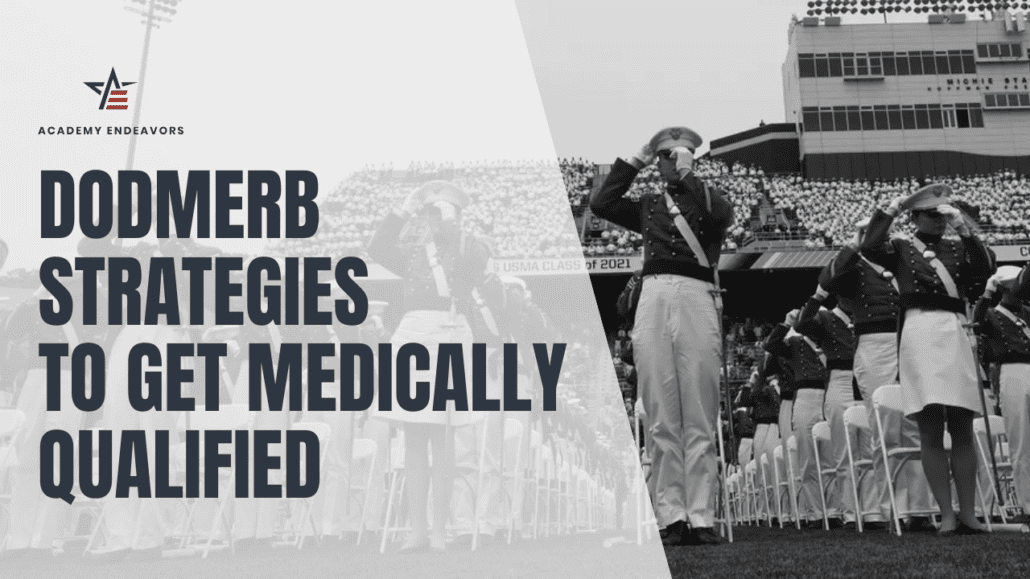DODMERB Strategies to Get Medically Qualified

Maybe this is a description of you right now: You submitted all your Academy and ROTC applications, received a Congressional nomination, and possibly even earned a Letter of Assurance. And then DODMERB hit, and it’s been a mess. You’re stuck in the medical waiver process. And here you are, only a few months before you have to report, and you don’t know if you’re going to get medically cleared. The future is completely up in the air, because of one thing: medical. Does that sound similar to your situation right now?
I get it. I personally went through the DODMERB process in 2003. DODMERB put me in remedial status just two months before basic training started. I ran around to obtain additional medical information so I could be qualified. Notice what I said…I didn’t submit my application early so that I’d have plenty of time for DODMERB. When I saw an orthopedic for a follow-up wrist evaluation, the doctor wrote a letter and we submitted the medical treatment notes to DODMERB, and I was cleared. Phew. Otherwise, I would’ve been medically disqualified and forced to re-apply.
Ladies and Gentlemen, my name is Travis Wittick with Academy Endeavors, and I’m here to help you NOT make the same mistakes I did. Go get your dream, and a pivotal part in doing so is getting medically qualified.
Why DODMERB Is A Hurdle For So Many Applicants
About 20% of applicants are disqualified by DODMERB every year. There are on average 30,000 applicants. You do the math. That’s 6,000 applicants disqualified every year, folks. The process can be lengthy, tedious, and unclear.
Here are four of the most common reasons why DODMERB is so challenging:
- There are lots of moving pieces. Between DODMETS, DODMERB, AMI, and waiver authorities it’s nothing short of a miracle when it works smoothly.
- There are tens of them and there are thousands of you.
- It all hits at once, and there’s a backlog.
- Everyone has a unique medical record, it takes time to wade through each file.
Our Goal at Academy Endeavors
There’s a lot of confusion and myths out there, so our dream is that all of you, 100% of you, get medically qualified. However, waivers are extremely limited, and some medical conditions are more waiverable than others, so our goal is to provide clarity as to how the process works, and how to increase your chances. This is your last big hurdle.
There are two groups of people listening:
- HS Seniors that are currently under waiver review.
- HS Juniors/Sophomores: checking out the process and trying to get prepared.
Our intent is to serve both groups with this presentation.
Before we get any further, we wanted to start with a few disclaimers
- Academy Endeavors are NOT doctors. We are NOT affiliated with the Department of Defense. We do NOT work for DODMERB.
- The medical process can test your integrity. We do not endorse lying. Falsifying your medical history can lead to confinement, fines, or dishonorable discharge.
- Academy Endeavors does not claim to be experts in every condition of the human body. If you ask us a question about anterior lymphoma of the spleen, we may not know. Each year there are new conditions that pop up that we research. See us as fellow sojourners with you in this process. If we don’t know, we will tell you.
- Our experience is based on:
- Going through the process ourselves as applicants.
- Guiding many candidates through the complexities.
- Years of experience in military healthcare.
- Publicly available information.
Bottom line: There are no insider trade secrets & there are no shortcuts to success.
With that said, we have had A LOT of success guiding our candidates to get waivers.
Academy Endeavors DODMERB Medical Waiver Success Rate
Last year, 100% of our clients received waivers.
And this year so far, 88% of our clients received waivers with 1 pending.
These aren’t just minor conditions that have been waived. We have seen major conditions waived, such as suicidal ideation, asthma, peanut allergies, and knee reconstructive surgery.
What we’re about to tell you is the same concepts we taught our own candidates.
Overview of the DODMERB Process
Here’s the way the process should work in 20 words or less:
Submit your Academy/ROTC applications, complete the DODMERB medical history questionnaire, attend two medical exams, DODMERB qualifies you.
Mission accomplished.
But if they don’t qualify you, then you will need a waiver…
What is DODMERB?
DODMERB is the name of the medical board that qualifies you medically for admission to the Service Academies and ROTC.
The Department of Defense Medical Evaluation Review Board is a small staff of about 20-40 people that sits in Colorado Springs. Comprised of physicians and administrative staff, they review medical records, bump them up to the DOD medical standards, and make a determination.
DODMERB covers both Academy and ROTC applicants, and you only have to go through it one time, even if you apply to multiple Academies/ROTCs.
DODMERB Process
| Phase 1: Complete your Academy Application |
When you submit your applications, the DODMERB process starts.
- Academies send your name/social security number to DODMERB.
- DODMERB emails you to set up your DODMETS portal, so you can move to Phase 2. DODMETS.com is the portal through which you will complete a medical history survey and book your medical appointments.
Note: For some Academy applications such as West Point, once you are 80% complete, the Academy will send your information to DODMERB.
Best Practice for Phase 1: Submit your application early.
This is the reality: Some applicants get stuck in waiver status late in the spring and don’t get cleared before basic training starts. Since DODMERB doesn’t review your medical until you submit your application – the longer you procrastinate on submitting your application, the less time you’ll have to get medical qualified or obtain a waiver. Do not underestimate how long the DODMERB process can take, folks.
| Phase 2: DODMETS |
| Phase 2a: DODMETS Medical History Survey |
In your DODMETS portal, you will take a 113 question survey on your medical history.
This is extremely important. What you say YES to has HUGE downstream complications.
Best Practices for Phase 2:
- Review the questions beforehand. There is no reason to be surprised at what they will ask. DD Form 2807-2 is what they will ask you to self-disclose.
- Look at the questions.
- See which ones will be YESs.
- Before answering yes, gather those records now.
- Obtain your medical records for your YES’s beforehand, and read them! Don’t assume your medical history, read what your doctor actually wrote. You may be surprised. Then, based on the evidence, self-identify your issues. Medical records are the gold standard.
- When the time comes, complete the medical history survey with a parent/guardian who knows your medical history. Remember, your YES answers lock and cannot be changed, so be careful!
| Phase 2b: Exams |
In your DODMETS portal, you will be assigned the nearest providers to you to schedule two exams: 1) a physical exam and 2) an eye exam. Call those providers and set up appointments.
Do everything you can to make the first available appointment, to keep the process moving.
| Phase 3: Pending |
During Phase 3, you are waiting for DODMERB to collect the documentation from your exams and your survey. This is a difficult wait, but one you must do for DODMERB to process and evaluate your medical history survey and two exams.
| Phase 4: Additional Medical Information (AMI) (if necessary) |
After DODMERB reviews your file, they might ask for Additional Medical Information (AMI). If they request AMI, it will be shown in your DODMERB portal and also in your email. When you receive the request, it is very important that you respond in a timely and comprehensive manner to everything they ask for, in the manner in which they ask for it. If they ask for PDFs, send it in PDF, not jpeg. If they ask for pharmacy logs from 2015 to present, send it exactly as they say the first time to avoid delays.
Best Practices for Phase 4:
- Stay on top of DODMERB correspondence. Check your DODMERB portal at least once per week. Be responsive to DODMERB emails.
- Set up your DODMERB Portal. This is a common mistake: applicants don’t understand that there are two portals, not one. The DODMETS portal is only for taking the survey and setting up your exam appointments. After that, it is mostly irrelevant. In Phase 4, set up your DODMERB portal by clicking “Continue” and then clicking “Login” in the upper left corner.
| Phase 5: Notification |
On your DODMERB portal, DODMERB notifies you whether you were qualified, or disqualified.
- If you are “qualified” here, the process ends! Congratulations!!!
- If you are “disqualified”, the process is not over. But it just became more complicated. Now you must need a waiver, so you will proceed to phase 6.
| Phase 6: Waiver Consideration (if necessary) |
Two things must be in place for you to be considered for a waiver:
- You must be medically disqualified by DODMERB
- You must be deemed “competitive” for a waiver by the Academies. DODMERB does not review all applicants for a waiver; only those that the Academy requests a waiver for will be considered.
Waivers are determined by the Academies/ROTCs, not DODMERB
The Services are the waiver authority. They get the final say.
DODMERB can medically disqualify you because you didn’t meet DOD medical standards. However, you still might meet Air Force, Navy, Army standards for waiver.
This is where it’s a bit of a black box. What gets waived? What does not?
What gets waived? What does not?
It usually depends on five things:
- The condition itself. Some conditions could be more likely to be waived than serious conditions. For example, we have seen eczema waived more than eosinophilic esophagitis. Some conditions are chronic, and some you can outgrow. Some conditions are chronic and limiting, while others are mild and can be healed with good therapy. The condition itself matters, first and foremost.
- The severity of the condition. How far outside of the DODMERB standards does your condition reside? For example, “lumbar or thoracic scoliosis greater than 30 degrees” is disqualifying. Is yours 31 degrees, or is it 51 degrees? This is for illustrative purposes only to communicate that the severity matters.
- The recency of the condition. For example, were you prescribed an inhaler as a 13 year old, or were you prescribed it last year as a 17 year old? Recency matters.
- The competitiveness of your file. Waivers are limited, and they want to give waivers to the most competitive applicants.
- The force strength of each service. When military personnel strength is low, more waivers are granted because the Services need more people.
- The agency itself. USAFA might waive something that USNA would not. Army ROTC might waive something that West Point would not. Each individual agency, Academy or ROTC, gets the right to waive.
Best Practices for Phase 6:
- Apply to more than one Academy/ROTC. If you are only applying to one Academy, you are putting all your eggs in one waiver authority basket, and your chance at a waiver is smaller.
You can’t know for sure what will get waived and what won’t, so have a winning strategy. Apply to more than one. Ex. A young man came to Academy Endeavors last spring because he was medically disqualified. Due to color deficiency. He had only applied to USNA. USNA, USMMA, and USCGA typically do not waive color deficiency, but what he didn’t know is that USAFA and USMA waive color deficiency more often. If he would have applied to another Academy, he might have been cleared, but he didn’t. Had he known what he knows now, he would have. Tough news.
- Obtain new medical documentation, if needed.
If after all this, you are still stuck in a waiver situation, then while you are waiting, depending on your situation, the best way to improve your chances of getting a waiver might be by obtaining medical documentation from a specialist pertaining to your condition.
- From the highest credential (MD, etc.)
- In the appropriate specialty (Allergy, Psychiatry, etc).
- Ideally one with a military background (eg, understands military requirements, ideally DODMERB).
Send the office notes and report into DODMERB, so they can forward to the waiver authority for review. It will be added to your file, and hopefully increase the chances of obtaining a waiver.
As if that wasn’t helpful enough, there is more.
When you call for an appointment, what should I say?
- Tell them your overall goal: “Hello, how are you doing today? My name is ________. I want to serve in the military, and I am seeking medical clearance to attend a Service Academy.”
- Tell them what you need: “The military needs documentation of my condition. I noticed Dr. ________ has a military background. May I please have the earliest appointment available to see him/her?”
- If they offer an appointment day/time that is too late, then ask to speak with the doctor’s nurse to see if you can get an earlier appointment.
Academy Endeavors Case Studies
The following examples represent real people who had difficulties obtaining waivers and reached out to Academy Endeavors for help. This is their anonymous story and good news result 🙌
Case Study #1: Young man and his parents came to us late in the application process.
Situation: Needed a waiver for 2 conditions: history of asthma and history of brain injury.
Action: We read his records, and discovered the following problems.
- Asthma. His medical records from his pediatrician were written in chicken scratch, difficult to decipher.
- Brain injury. He kept telling us that he had no concussions after that one time. But his most current medical record about brain injury was in 2016, and it said his symptoms were still constant. He had no current medical record saying he had been healed.
Recommendation
Asthma.
- Recommended he return to pediatrician and get a narrative summary clarifying his history & severity of asthma, and endorsing him for military service.
- Recommended he find a second opinion from a pulmonologist
- Send both reports into DODMERB
Brain Injury.
- Recommended he go back to the doctor to clarify how many incidents he truly had, and clarify whether he had concussive symptoms after the incident.
- Recommended, if time permitted, that he see a neurologist and receive a neuro evaluation to clarify whether there are still brain injuries currently.
- Send both reports into DODMERB
Result.
- Medical Clearance to West Point 1.5 months later.
Lesson Learned:
- Clarity matters. If you confuse, you lose.
- The more recent the better.
- DODMERB’s baseline is paranoid, and every medical record you submit should ease their concern. They don’t want to authorize a $300K scholarship to be given to someone who can’t deploy.
- Medical Records are gold. If that still didn’t do the trick, then we would have had them pursue a neuro eval with a neurologist, and a pulmonologist PFT and MCT tests for the lungs. More records with higher credentials. And if that didnt work then we would have found them a pulmonologist and neurologist with a military background, and turned in more evidence.
Case Study #2: Young man and his parents came to us early in the admission cycle.
Situation: Re-applicant, disqualified previously for 3 conditions: Suicidal ideation, learning accommodations, eczema
Problems:
We analyzed his medical records and saw the following problems:
- The family kept telling us he wasn’t really suicidal. But in his records, the ER visit note clearly stated he was.
- He saw a counselor for 6 months after the incident, but there hadn’t been an updated note from the therapist since his last appointment as a 15 year old.
- His learning accommodations were based on a ADHD and learning disability diagnosis from when he was in 4th grade, and had never been updated.
- There were no records at all from eczema, except a self-disclosed YES on his DODMERB medical history questionnaire
Recommendations:
- Recommended he see his counselor again and have an updated mental health evaluation. Also found a psychiatrist with military background to do an independent assessment as 2nd opinion. Submitted both to DODMERB.
- Recommended he go back to the child psychologist and get re-tested for ADHD, then if it went well, get off of accommodations completely. Got re-tested, did not meet criteria for the diagnoses anymore. Got off accommodations and performed well w/o accommodations his senior year of high school. Got a letter from his guidance counselor and signed by all his teachers stating he only used accommodations for one of the 4 things listed in his IEP. Submitted both and his transcript to DODMERB.
- Found a dermatologist with military background to evaluate his eczema, and sent letter from dermatologist to DODMERB.
Result
- Medically cleared of all 3 conditions. USMA appointment.
Case Study Lessons Learned
- Clarity matters. If you confuse, you lose.
- The more recent, the better. The longer the gaps, the more reason for concern.
- DODMERB has the right to be concerned unless the medical record proves otherwise. They don’t want to authorize a $300K scholarship to be given to someone who can’t deploy.
- Medical Records are gold. Typically, the higher specially from specialists and even more so specialists with a military background.





